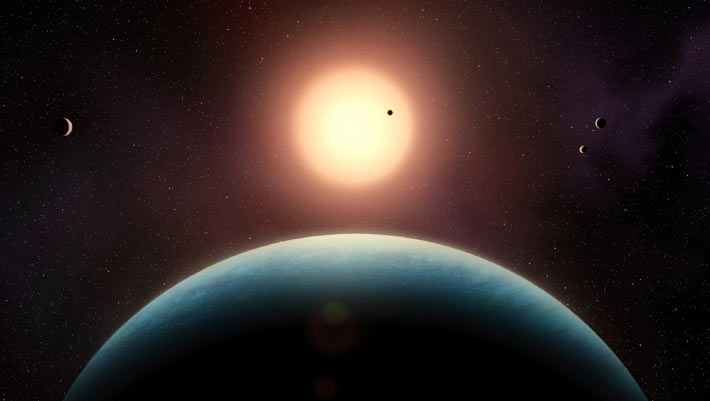Named L 98-59f, this planet is a non-transiting super-Earth with a minimal mass of 2.8 Earth masses on a 23-day orbit inside the habitable zone of the small red dwarf L 98-59.
An artist’s impression of the L 98-59 planetary system; in the foreground is the habitable-zone super-Earth L 98-59f. Image credit: Benoît Gougeon / UdeM.
L 98-59, also known as TOI-175, TIC 307210830, is an M dwarf about one-third the mass of the Sun.
The system lies approximately 34.5 light-years away in the southern constellation of Volans.
It features three transiting exoplanets, identified by TESS in 2019, in compact orbits of 2.25, 3.7, and 7.45 days, with an outer 12.8-day non-transiting planet confirmed in 2021 using ESO’s ESPRESSO spectrograph.
These planets exhibit a diverse range of sizes (0.8-1.6 Earth radii), masses (0.5-3 Earth mases), and likely compositions (Earth-like to possibly water-rich).
In a new study, Université de Montréal and Trottier Institute for Research on Exoplanets astronomer Charles Cadieux and his colleague carefully reanalyzed TESS, ESPRESSO, HARPS and Webb data.
They were able to determine the planets’ sizes and masses with unprecedented precision.
“We refine the radii of L 98-59b, c, and d to 0.84 Earth radii, 1.33, 1.63, respectively,” they said.
“We also report updated masses of 0.46 Earth masses for L 98-59b, 2 for L 98-59c, and 1.64 for L 98-59d, and a minimum mass of 2.82 for L 98-59e.”
The astronomers also confirmed the existence of a fifth planet, L 98-59f, in the star’s habitable zone, where conditions could allow liquid water to exist.
“Finding a temperate planet in such a compact system makes this discovery particularly exciting,” Dr. Cadieux said.
“It highlights the remarkable diversity of exoplanetary systems and strengthens the case for studying potentially habitable worlds around low-mass stars.”
“These new results paint the most complete picture we’ve ever had of the fascinating L 98-59 system,” he added.
“It’s a powerful demonstration of what we can achieve by combining data from space telescopes and high-precision instruments on Earth, and it gives us key targets for future atmospheric studies with the NASA/ESA/CSA James Webb Space Telescope.”
The refined measurements reveal nearly perfectly circular orbits for the inner planets, a favorable configuration for future atmospheric detections.
“With its diversity of rocky worlds and range of planetary compositions, L 98-59 offers a unique laboratory to address some of the field’s most pressing questions: What are super-Earths and sub-Neptunes made of? Do planets form differently around small stars? Can rocky planets around red dwarfs retain atmospheres over time?” said Université de Montréal’s Professor René Doyon, director of Trottier Institute for Research on Exoplanets.
The team’s paper will be published in the Astronomical Journal.
_____
Charles Cadieux et al. 2025. Detailed Architecture of the L 98-59 System and Confirmation of a Fifth Planet in the Habitable Zone. AJ, in press; arXiv: 2507.09343
